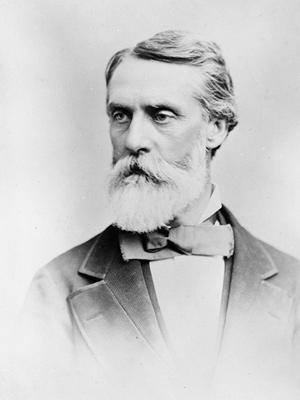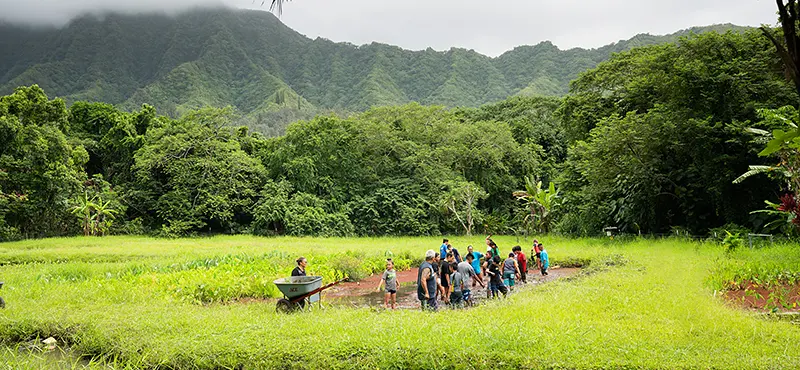Charles Reed Bishop

Charles Reed Bishop
Charles Reed Bishop, husband of Kamehameha Schools founder Bernice Pauahi Bishop, was the driving force that brought his wife’s wishes to fruition and a very important and well respected citizen of the Hawaiian Kingdom in his own right.
Born January 25, 1822 in Glens Falls, New York, Bishop grew up on his grandfather’s 120-acre farm learning to care for sheep, cattle and horses and repairing wagons, buggies and stage coaches. He attended seventh and eighth grades at Glens Falls Academy, which completed his formal education, then worked in mercantile establishments clerking; bartering, bookkeeping, inventorying and running a lumber yard and farm.
By January of 1846, Bishop was ready to broaden his horizons. He and a friend, William Little Lee, planned to travel to Oregon, Lee to practice law, and Bishop to survey land. Their journey, however, ended in Hawai‘i in October 1846 where both men decide to stay for awhile, a period for Bishop that stretched into nearly half a century.
Bishop easily found work, first at Ladd and Company, a mercantile and trading establishment, then at the U.S. Consulate in Honolulu. In 1849, Bishop signed an oath to "support the Constitution and Laws of the Hawaiian Islands" and was appointed collector of customs for the kingdom.
In short succession he married Bernice Pauahi, was made a lifetime member of the House of Nobles, joined the Privy Council, became Collector General of Customs, helped organize the Royal Hawaiian Agricultural Society, opened a bank under the name Bishop and Company [the predecessor of First Hawaiian Bank], and generally without realizing it, laid the foundation for his leadership in the community. (From Charles Reed Bishop, Man of Hawaii by Harold W. Kent)
Despite his many business ventures, Bishop managed to serve Kings Kamehameha the IV, Kamehameha V, Lunalilo and Kalakaua in a variety of positions such as: foreign minister (handling treaties with Austria, Germany, Denmark, France, Russia and the United States); president of the board of education; and chairman of the legislative finance committee. He also sat on the boards of many charities and donated generously to Hawai‘i schools, hospitals, churches and social welfare organizations.
Bishop met Pauahi while she was still a student at the Chiefs’ Children’s School and against her parents wishes, he courted and married her in 1850. His letters that mention Pauahi reveal a deep respect and affection for his wife and suggest she was a major source of his happiness throughout their 34-year marriage. Soon after her death in 1884 he wrote:
"I know you all loved her, for nobody could know her at all well and not love her. For myself I will only say that I am trying to bear my loss and my loneliness as reasonably as I can looking forward hopefully to the time when I shall find my loved one again."
Immediately after Pauahi’s death, Bishop, as one of five trustees she selected to manage her estate and co-executor of her will, set in motion the process that resulted in the establishment of the Kamehameha Schools in 1887. Because Pauahi’s estate was basically land rich and cash poor, Bishop contributed his own funds for the construction of several of the schools’ initial buildings on the original Kalihi campus: the Preparatory Department facilities (1888), Bishop Hall (1891) and Bernice Pauahi Bishop Memorial Chapel (1897). In addition, he founded and endowed the Bernice Pauahi Bishop Museum in 1889 as an enduring memorial to his wife.
…Being interested in her plans and wishes and because of her very generous gifts to me…I decided to carry out her wishes regarding the schools and promised to do something toward a museum of Hawaiian and other Polynesian objects…in order to accomplish something quickly without sacrifice or embarrassment of her estate, I soon reconveyed to her estate the life interests given by her will and added a considerable amount of my own property on Oahu, Hawaii and Molokai…(C.R. Bishop letter to Samuel Damon, 1911)
In 1894, Bishop left Hawai‘i to make a new life in San Francisco, California. Until he died in 1915, he continued, through correspondence with the schools’ trustees, to guide the fiscal and educational policy-making of the institution in directions that reinforced Pauahi’s vision of a perpetual educational institution that would assist Native Hawaiians to become "good and industrious men and women." (Bernice Pauahi Bishop’s Will, 1883) In accordance with Bishop’s expressed wish, his ashes were returned to Hawai‘i and interred in the Kamehameha Tomb at Mauna ‘Ala by the side of his wife.
Visit the Charles Reed Bishop Trust website »











